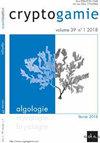New Data on the Morphology, Reproduction and Distribution of a Freshwater Brown Alga Porterinema fluviatile (Porter) Waern (Phaeophyceae)
IF 1.5
4区 生物学
Q3 MARINE & FRESHWATER BIOLOGY
引用次数: 1
Abstract
ABSTRACT This paper provides information on the morphology, reproduction and distribution of a freshwater brown alga, Porterinema fluviatile (Porter) Waern (Phaeophyceae). The alga was recorded in oligotrophic water from Mlava Spring, a karst limnocrene in eastern Serbia (44°11′298″N, 21°47′021″E). This is the first record of freshwater brown algae in general in Serbia, and the first record of P. fluviatile in southeastern Europe. The thallus of P. fluviatile formed small, dark-brown tufts, with multicellular, uniseriate filaments that were irregularly branched. An anastomosis was noticeable between some filaments. The vegetative cells of the young filaments were cylindrical (17-38 µm long × 2.5-4.0 µm wide). The cells had 1 or 2, rarely 3, plate-like parietal plastids. The reproductive organs of P. fluviatile (asexual reproduction) originate from the transformation of vegetative cells. Elongated vegetative cells develop inflated vegetative cells (5-10 µm in diameter) with lipid droplets. Further transformation of these cells leads to the formation of intercalary plurilocular sporangia with 4 to 8 (rarely 16) cells. Nonmotile, round aplanospores, which develop by protoplast division in elongated vegetative cells, are described for the first time in this species.淡水褐藻Porterinema fluviatile (Porter) Waern (Phaeophyceae)形态、繁殖和分布的新资料
本文介绍了淡水褐藻Porterinema fluviatile (Porter) Waern (Phaeophyceae)的形态、繁殖和分布。该藻类记录于塞尔维亚东部喀斯特湖泊Mlava泉(44°11′298″N, 21°47′021″E)的贫营养水中。这是塞尔维亚淡水褐藻的第一次记录,也是东南欧第一次记录流动藻。流草的菌体形成小的、深褐色的簇,具有不规则分枝的多细胞单株花丝。一些纤维间有明显的吻合。幼丝的营养细胞呈圆柱形,长17 ~ 38µm,宽2.5 ~ 4.0µm。细胞有1个或2个板状顶板质体,很少有3个。无性生殖的生殖器官是由营养细胞转化而来。伸长的营养细胞发育成膨胀的营养细胞(直径5-10µm),脂滴形成。这些细胞的进一步转化可形成含有4 - 8个(很少有16个)细胞的蝶间多眼孢子囊。非运动的圆形无定形孢子在细长的营养细胞中由原生质体分裂而成,在本种中首次被描述。
本文章由计算机程序翻译,如有差异,请以英文原文为准。
求助全文
约1分钟内获得全文
求助全文
来源期刊

Cryptogamie Algologie
生物-海洋与淡水生物学
CiteScore
2.60
自引率
7.70%
发文量
11
审稿时长
>12 weeks
期刊介绍:
Cryptogamie is a fast-track and peer-reviewed journal of international scope publishing in English only. It accepts original papers and review articles on the taxonomy, biology and ecology of all cryptogams. An issue of Cryptogamie may be devoted to a single topic, under the responsibility of guest editor(s). All articles published in Cryptogamie are compliant with the different nomenclatural codes. A copyright assignment will be signed by the authors before publication.
Cryptogamie, Algologie accepts articles on systematics as well as ecology and evolution of any kind of algae (including Cyanobacteria).
 求助内容:
求助内容: 应助结果提醒方式:
应助结果提醒方式:


